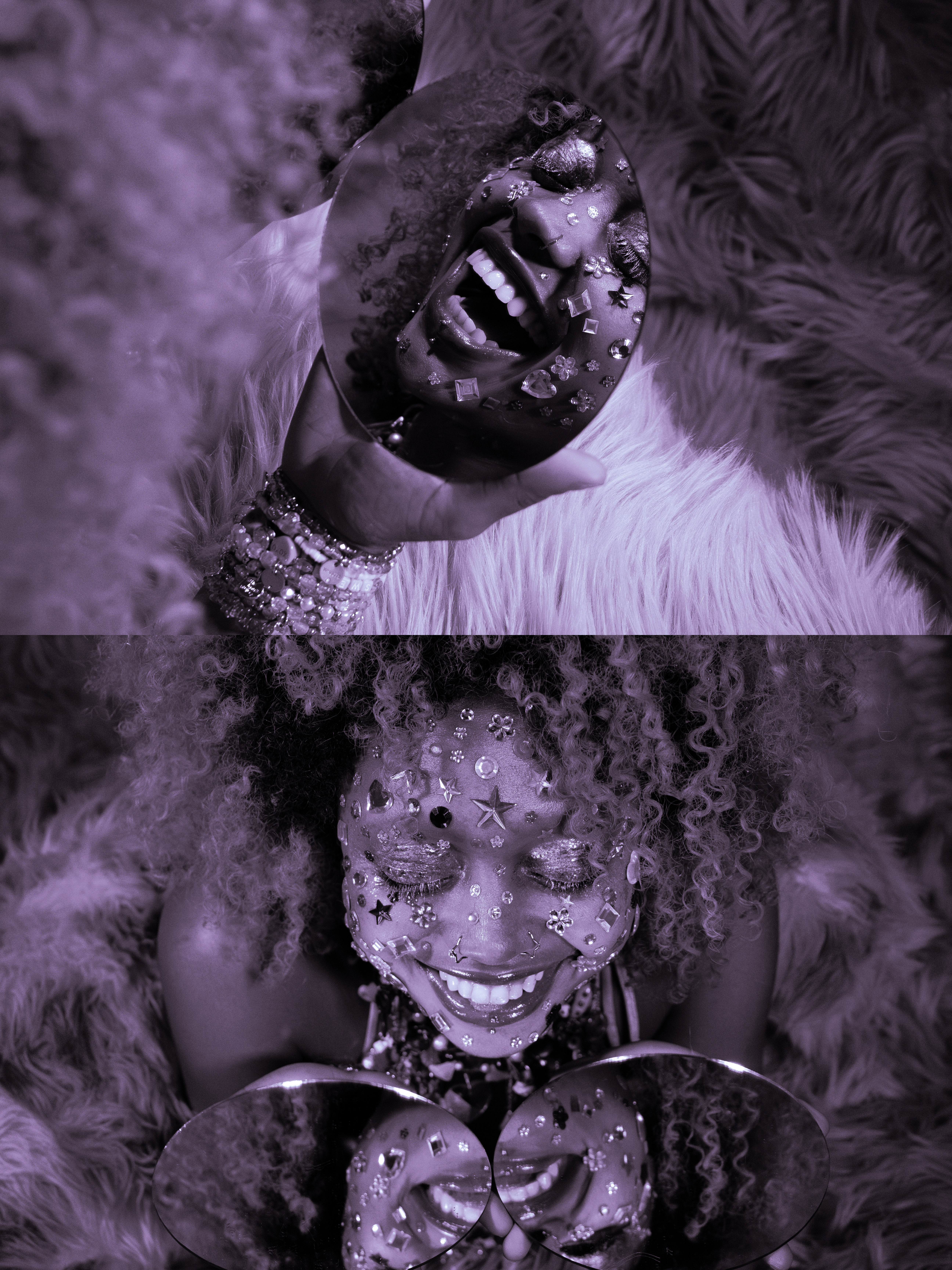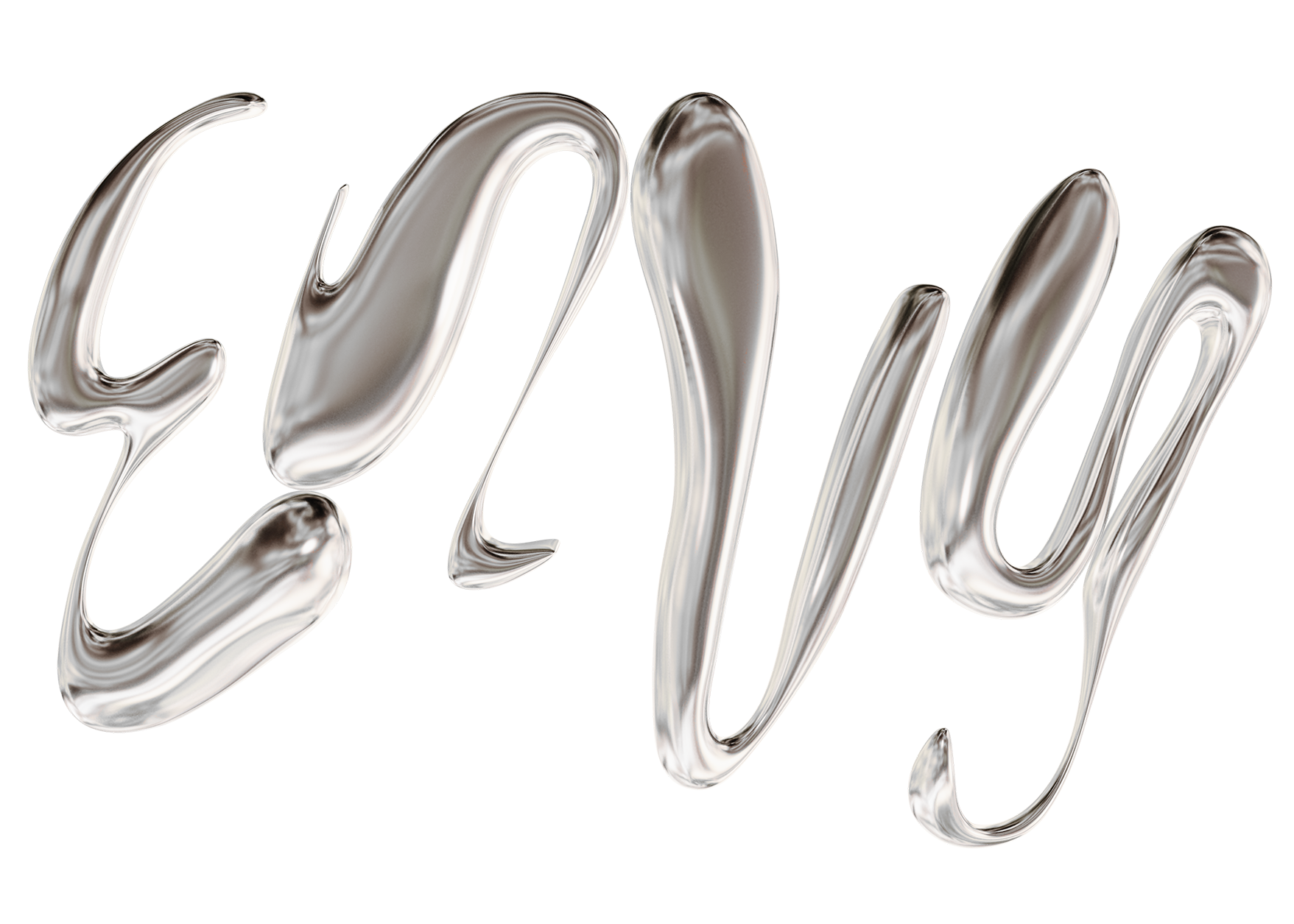AUTHENTIC EXPRESSION, UPCYCLED BALENCIAGA, & TOUCHING THE ART?
... SAY LESS
INTERVIEW WITH TRACI JOHNSON (THEY/THEM)
Photos by Kaden Bard Dawson
Words by Danielle Gaudus
4.30.25
“I have free will, I can make the decision to be happy and look like myself and express myself in a certain way”
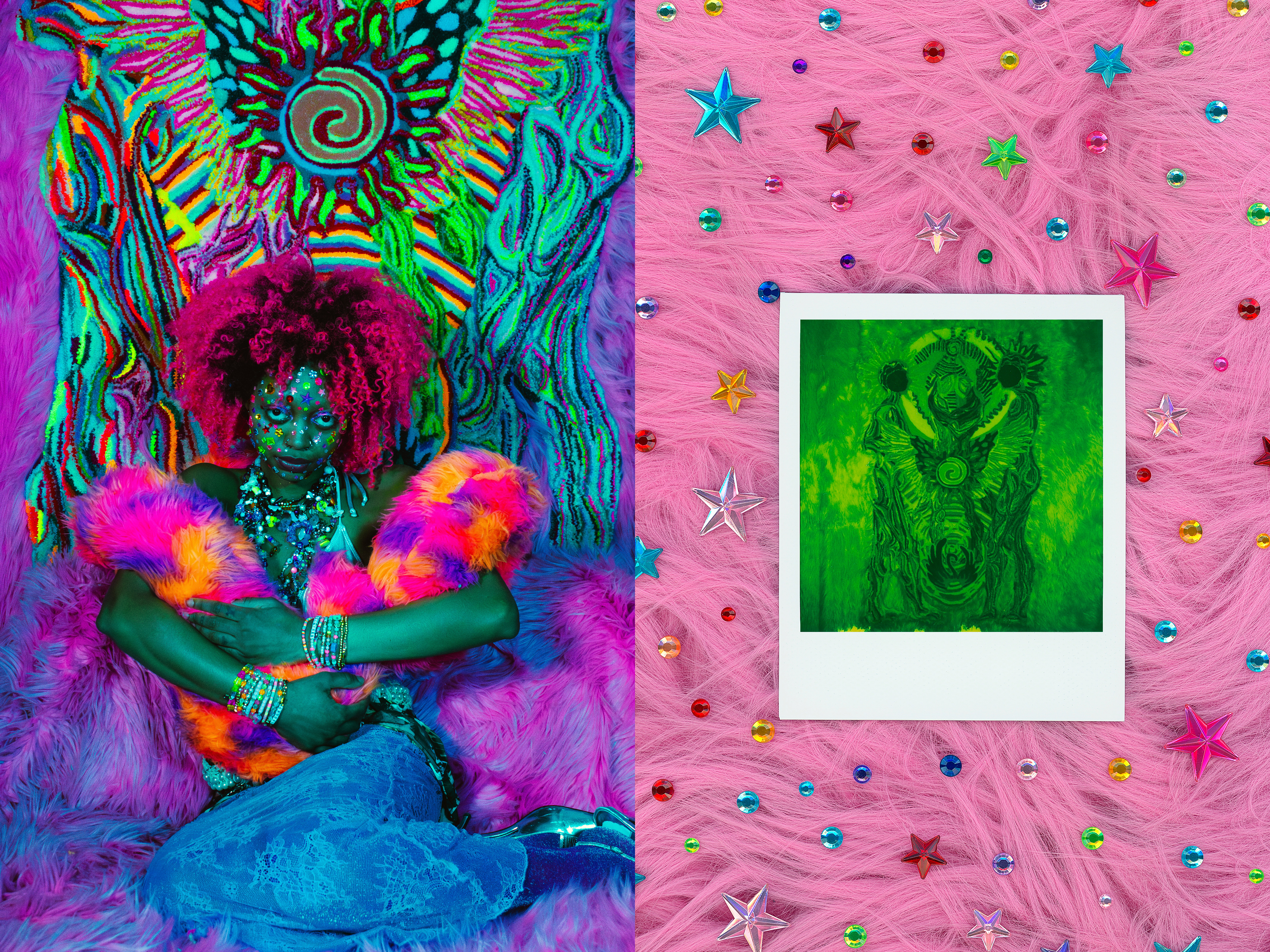
Greeting us with a big smile, chromatic outfit, and hot pink hair, Traci guides us down a labyrinth of white walls and grey cement floors of their Gowanus Studios. We’re intuitively drawn to their magnetic studio space. Warmth emanates. Pink fur-lined walls are decorated with beautiful rugs and soft sculptures, depicting either figurative scenes of quantum friends and lovers or promiscuous femme silhouettes. The Brooklyn-born artist knows how to take you on an astral adventure.
Embracing touch, sensuality, and sexuality, their artistic practice creates a world of its own. Their “Safe Space” installation can be experienced at the 50th St. 1 platform; a habitat of vibrance and funky flavors contrasts with the grime of the underground station. Currently on residency at Factory on Willow, they continue to push their exploration of expression through the process of rugmaking, soft sculptures, and spatial installations.
Our conversation reminded us of the importance of being yourself and having FUN! In addition to organizing your professional life, even as a creative. Truly an artist who is carving their own path, we dive into their journey: where they’ve come from and where they’re going.
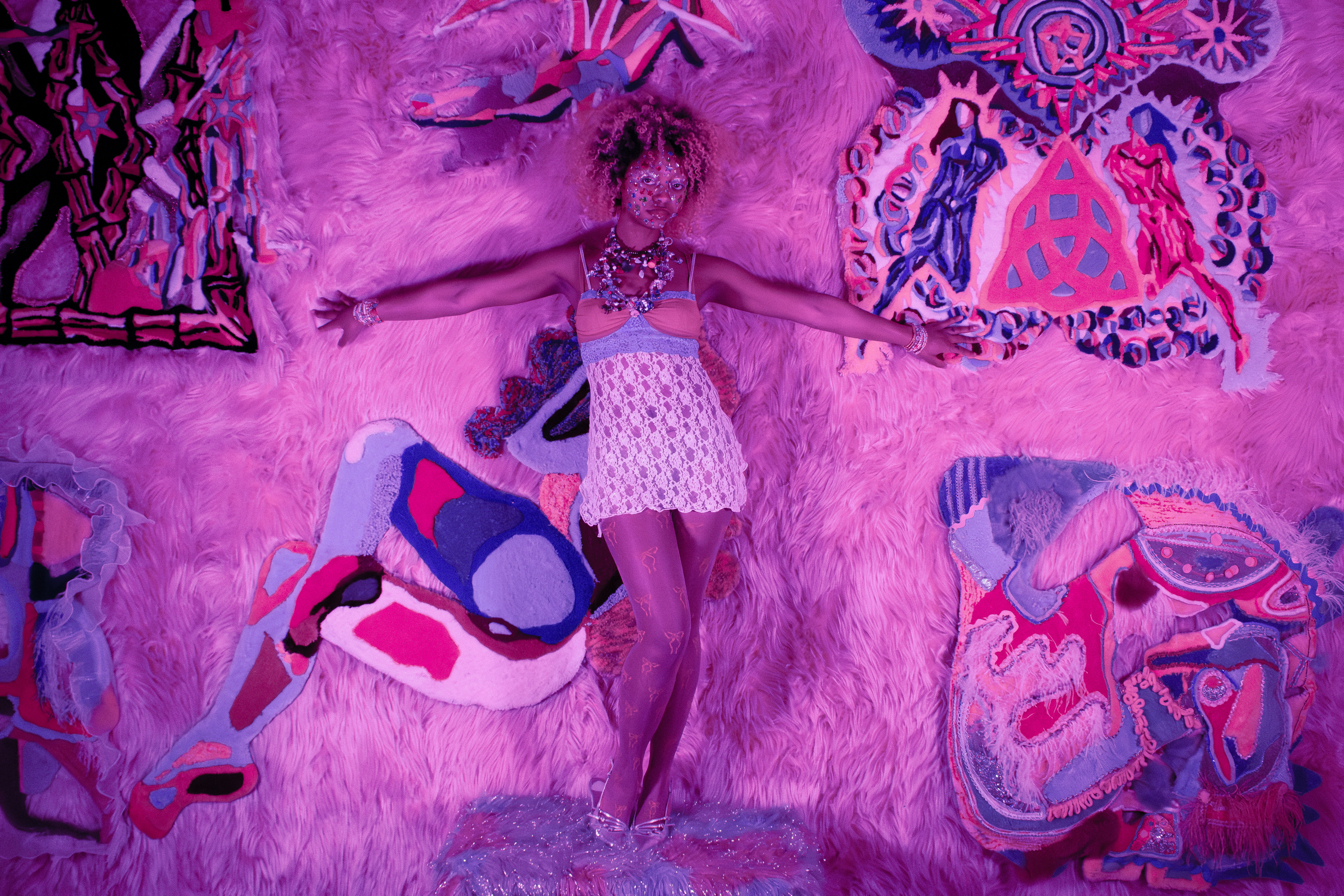
D: So, it'd be cool to start from the beginning. Let’s hear your origin story. How did you find your way to your artistic expression and your practice?
T: I was always into arts and crafts and stuff as a kid, I played soccer, I did ballet. It wasn't until I was a little older in high school [that I started to develop as an artist]. I went to the High School of Fashion Industries, then I went to FIT for fine art.
I would always say to myself, if I'm going to go to school for something, I'm going to want a career out of it. So I think that's what pushed me into the arts. And then, I don't know, I also just never saw myself doing a nine-to-five moment. It always had to be something creative, like either dance or art or something.
D: We’re in your studio now, and it’s so vibrant here. There's such a sense of child-like play and fun! I’m curious what creative expression was like for you as a kid, but also now as an adult. Did you have to rediscover that essence? Or have you maintained a sense of fearlessness in response to societal standards?
T: So when I was a kid, I was very happy. I was happy, and I am happy, and I try to maintain that. I grew up Christian, and so I grew up with a lot of strict rules on how you're supposed to look, how you're supposed to carry yourself. You can't look a certain way, like I couldn't have colored hair, or wear ripped jeans. I couldn't wear miniskirts. So, I think, honestly, that contributed to me wanting to have a space to express myself where people weren't judging me, and they were a lot like growing up in church. Which is crazy because I went to high school for art. I went to art college. I went to very expressive schools, and I still felt like I didn't have like autonomy over the way that I looked, I always had to ask permission if I wanted to do something to my body or get a piercing or change my hair, and it would always be like, no.
So I feel like that is where my work stemmed from. I guess trying to get that back. I have free will, I can make the decision to be happy and look like myself and express myself in a certain way. So I think it was always there, it just wasn't able to come out due to being raised in a very strict environment.
D: What do you feel like that “opening up” process was for you? Was there a breakthrough moment for you, or did it evolve over time?
T: Yeah, I think it was overtime. In middle school, I remember I was dyeing my hair in the library, and I was getting piercings on St. Mark's Street (that's where all the teenagers go to get their piercings). So the septum piercing was the first piercing that I got, because it's easy to hide from your parents. And then, I think junior year, I started bleaching and dyeing my hair.
Usually, my mom was the person to be like, “you can't do this, I don't like it,” because she would like have people in her ear saying, “um you know your child's never going to get a job looking like this… how could you let your child do something like this?” But once I started seeing other people in my high school wearing American Apparel, I began to realize, I don't understand what's so wrong with expressing yourself and trying to figure out who you want to be. I went to FIT too, everyone looked crazy, and I was like, okay, I feel at home. So it just happened over time. Then, as I've shown my work more, my family has been more open-minded and seeing that it's okay.
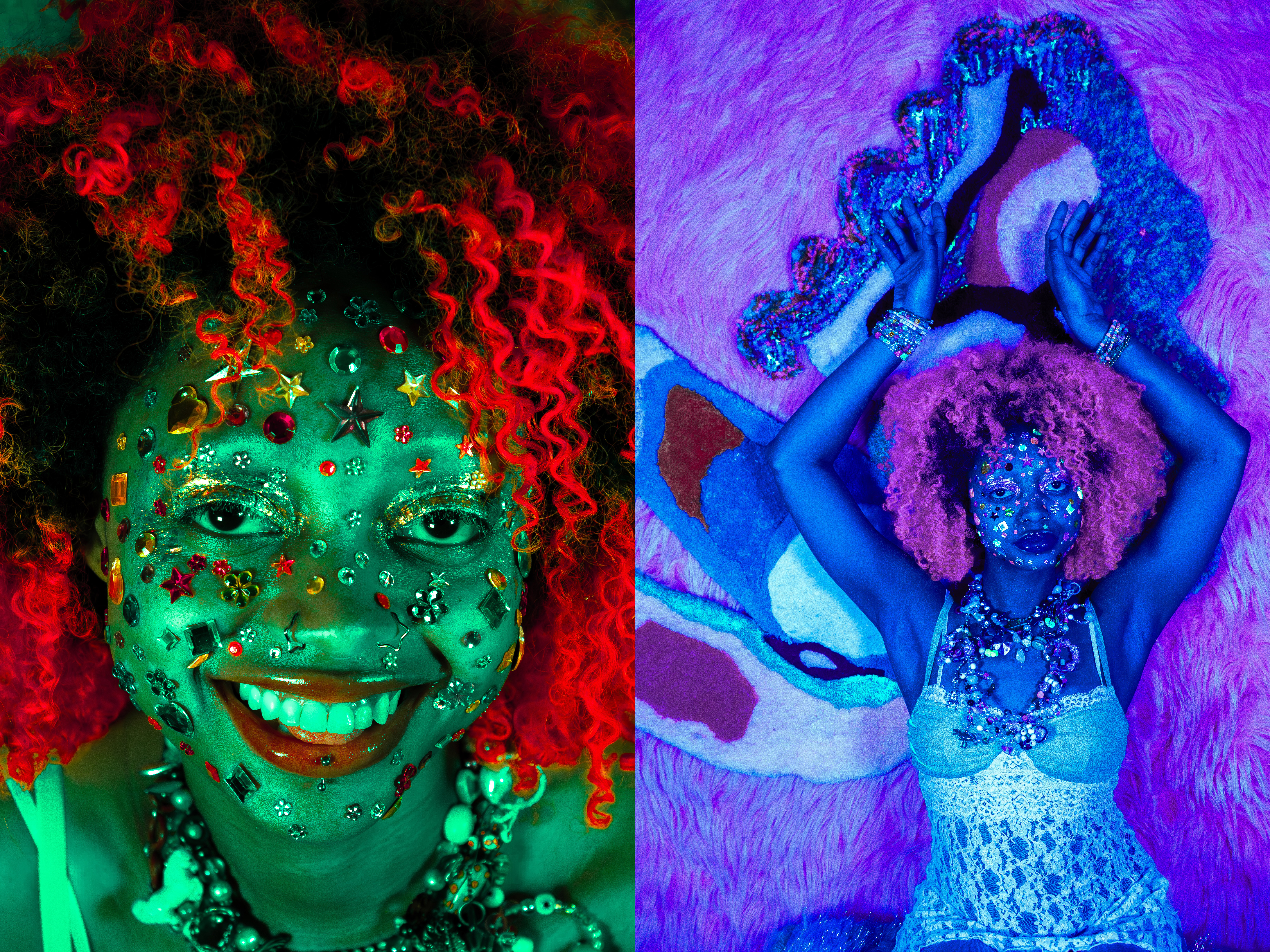
D: I see this connection to your work of creating safe spaces to be yourself and for others to be themselves. Do you think the strict rules set out for you influenced this?
T: Growing up, I didn't have like a crazy, unsafe space, but I just wasn't comfortable being myself. So even certain things, like I don't come out to my mom about everything I do. Because there’s still kind of like that shame that trickles in a little bit. But that’s what I’m working through in my art, and why I have the space for myself but also for others.
D: Okay. So what are Traci’s ingredients for a safe space? I'm curious to hear what the definitions or markers of these safe spaces are for you.
T: Okay, so definitely very vibrant colors, very like soft materials. I’ve always loved animals and the way animals make me feel. So that is where the faux fur aspect and the soft sculptures came from; you can wrap yourselves around in the soft sculptures, kind of like pillows or heated blankets. Then you're also caressing the fur and caressing the sculptures, so that boosts your serotonin. Things that make you feel comfortable and also happy at the same time.
Also, I'm someone who likes to touch more than one sense in my art. So it’s not just visual, but I would love to smell like certain things, or I like touch and sound as well. I listen to a lot of music when I'm making my work. Frequency is like healing! What else makes a safe space? Definitely people that you love. I really like to have people coming into the studio, and they just chill and hang out.
I want to start incorporating meditation or yoga into my safe spaces so as much as the space is giving to you, you give back to the space. It's like the energy is always being returned to one another.

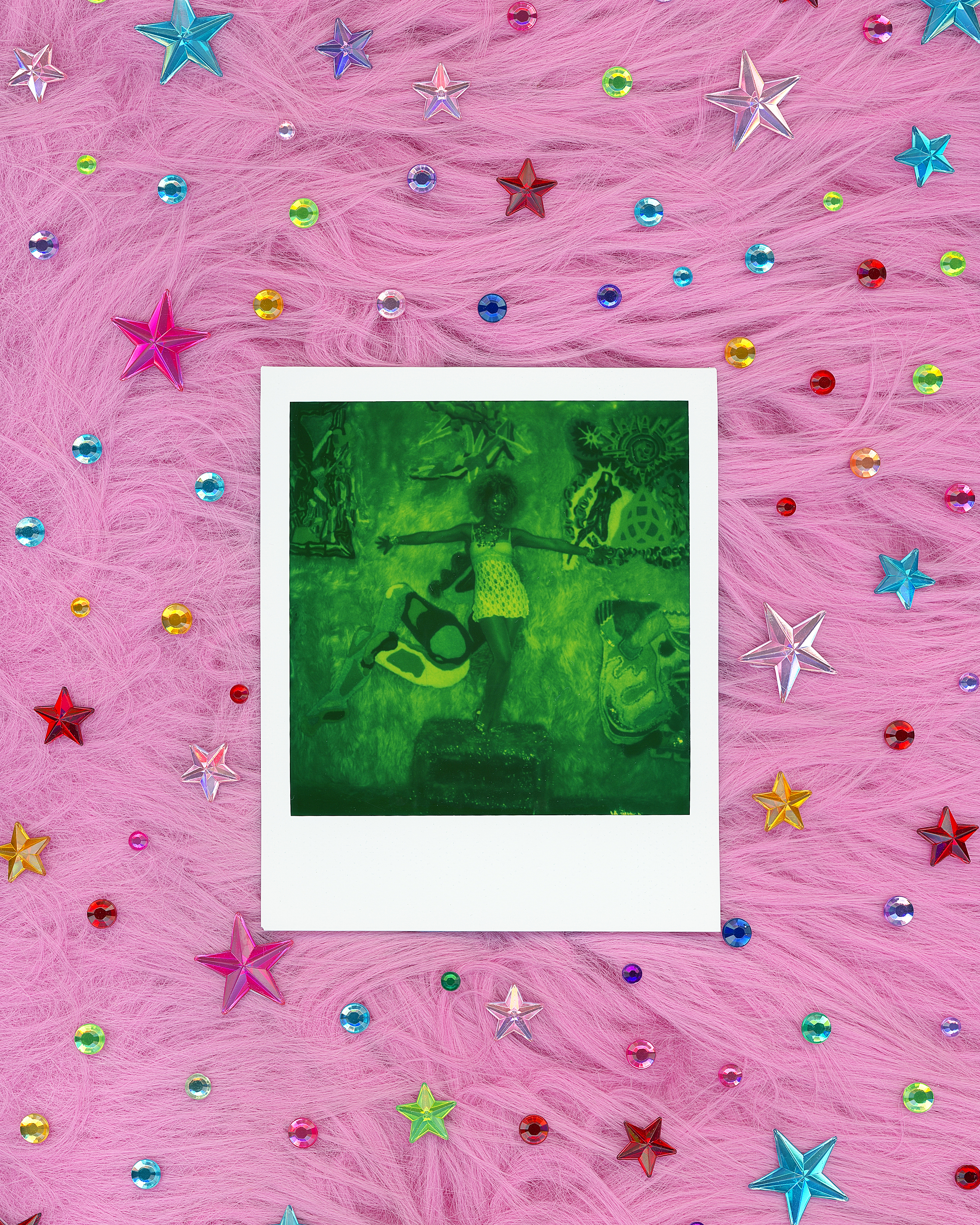
D: I’d love to hear about your attraction to bright colors. In an age where everyone is wearing black and brands are shifting to standardized Sans Serif fonts, creating a furry hot pink room is kind of revolutionary.
T: So when I started painting, I always painted very vibrantly. I've always been attracted to color and the way it makes me feel. The hot pink? I don't even know how it happened. I was dyeing my hair pink… yellow is actually my favorite color, but over time, pink became my color. Then I began to make these rooms covered in faux fur. This pink actually came from when Balenciaga did their store covered in pink fur. So this is honestly their fur. They just donated it. Upcycled Balenciaga.
And that color has traveled through my work in general. I actually have so much faux fur, I have dark blues, and I know different colors make you feel certain things. Blues are really calming or insulating. But it's intuitive when I choose my colors for my work. I'm seeing how they sing next to each other and how they make me feel when I'm looking at them, and it's just a feeling. I don't know how to even describe it. I love when people are talking about mixing their senses, like saying the colors are singing. It’s not just how they look together, it's like how they're vibrating.

D: School can be really formative for a lot of people. So I'm curious about this experience of an arts high school, then an arts college. What was that like for you in general in shaping your practice? How did you discover rugs and textiles as a medium?
T: So in college. I will say that my first few years, I was just doing work. Like, I was just doing homework. I was like, “yeah, I gotta do a fucking still life.” It wasn’t as enjoyable as it is now. And I think it's because it's college, you're learning very foundational things, very technical things. And I always thought like in school, like, oh, you're just supposed to like, do whatever you want. I thought that was kind of just how you make art; you never know, but you find out what works for you.
In my college, I could count on my fingers how many black kids there were. There were no black teachers. We weren't really learning about people or artists that looked like me, we were learning very European-based western art. So in school. I was always trying to figure out what kind of art I should make, or how to make black art, or how to speak for my people. But then it took a long time for me to also realize that all the art that I make is going to be black because I'm black. I don't necessarily have to talk about being black, like in my work. So I struggled a lot with what I wanted to say, what I wanted to talk about. I feel like in college if you weren't painting realistically, you weren't getting encouragement.
It's crazy because it was very traditional. So you're printmaking, you're oil painting, and you're doing sculpture, but not everyone is a painter, but that's something that they heavily focused on at my college.
I got into making soft-sculpture in 2019, and I started making the safe spaces on a very small level with crochet. At that point, instead of me stuffing the soft sculptures, they were actually wood sculptures, and I wrapped yarn and things around them. So that's where the softness kind of started, because I realized that it wasn't really being celebrated in painting. I also just enjoyed very tactical, making things with my hands instead of staring at the canvas, and so on. Then the pandemic happened, and I saw people making rugs like on Instagram and TikTok, and at that time, it was very crazy; we weren't allowed to go back to school and get our materials. So we were just working off the strength of like vibes. I was like, well, rugs are a good in between, between my soft sculptures and between painting. And that's how I got into the rugs.
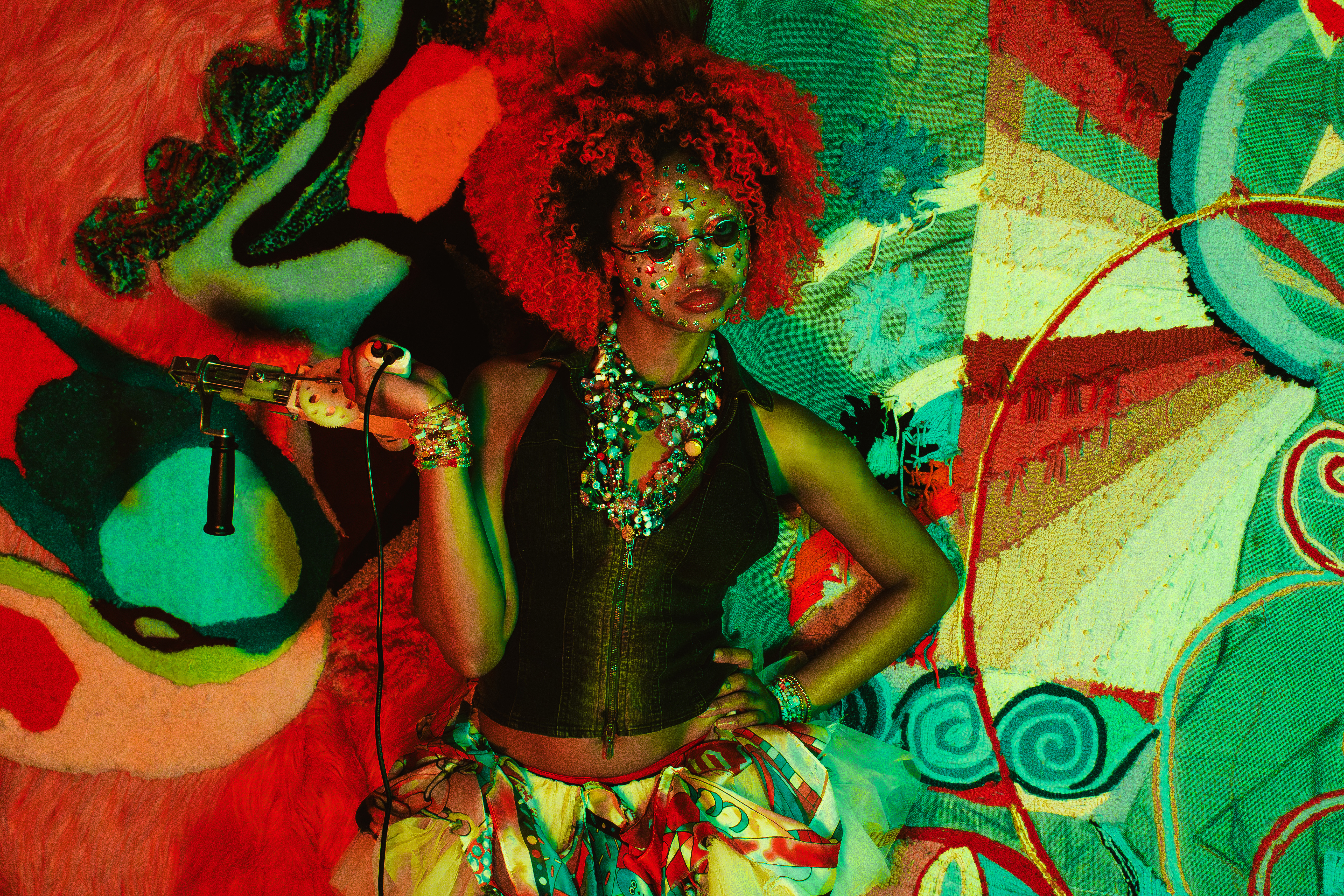
D: Do you have references or artists you look up to?
T: So I know this is probably gonna be a controversial pick but whatever, when I was in high school, Yayoi Kusama, her infinity rooms were always showing, like it's rare to catch an infinity room in New York now, but, she was always showing infinity rooms like when I was in high school. So I saw the polka dot room. And I loved how immersive the spaces were, and you were kind of like a part of the work. They gave you polka dots, and you got to, like, polka dot the room yourself. It started off as a white room at first then became filled with dots. So she's one of my influences.
I love Nick Cave, he makes Sound Suits and they're figurative sculptures made out of all these found materials. Tschabalala Self, I really love her and her like figurative work.
D: Do you feel that separation, while you were away from school, and away from these professors trying to put you in a box, opened things up for you?
T: Honestly, I was home for so long, for months, and then I realized that I'm someone who needs to actually do something and make use of my time. Before I really wasn't focused in school, I was sleeping during class. Like I was chilling.
And then something shifted in 2020 with the mass protesting, everything that was happening, I live across from two bridges, I was seeing them protest [on the Brooklyn Bridge]. I was like, okay, what can I do? How can I help? So I started making kits, and I brought all my friends together to make kits for the protesters.
At that point, I had started making my rugs in my bedroom, but the noise was very crazy. And so I was like, okay, I need a space. So I had the money, I had the vision, I liked this medium. And then I was like, I also know what people need. Third spaces [a social environment separate from home and work, where people can connect with others] are really popular now too. And so that kind of idea of having a space that looks like you. And then also creating work. Now the work that I'm creating is definitely much better than I was making like five years ago, but that's honestly flipping the switch of like, you have this time use it wisely, use it well, and make something of yourself.
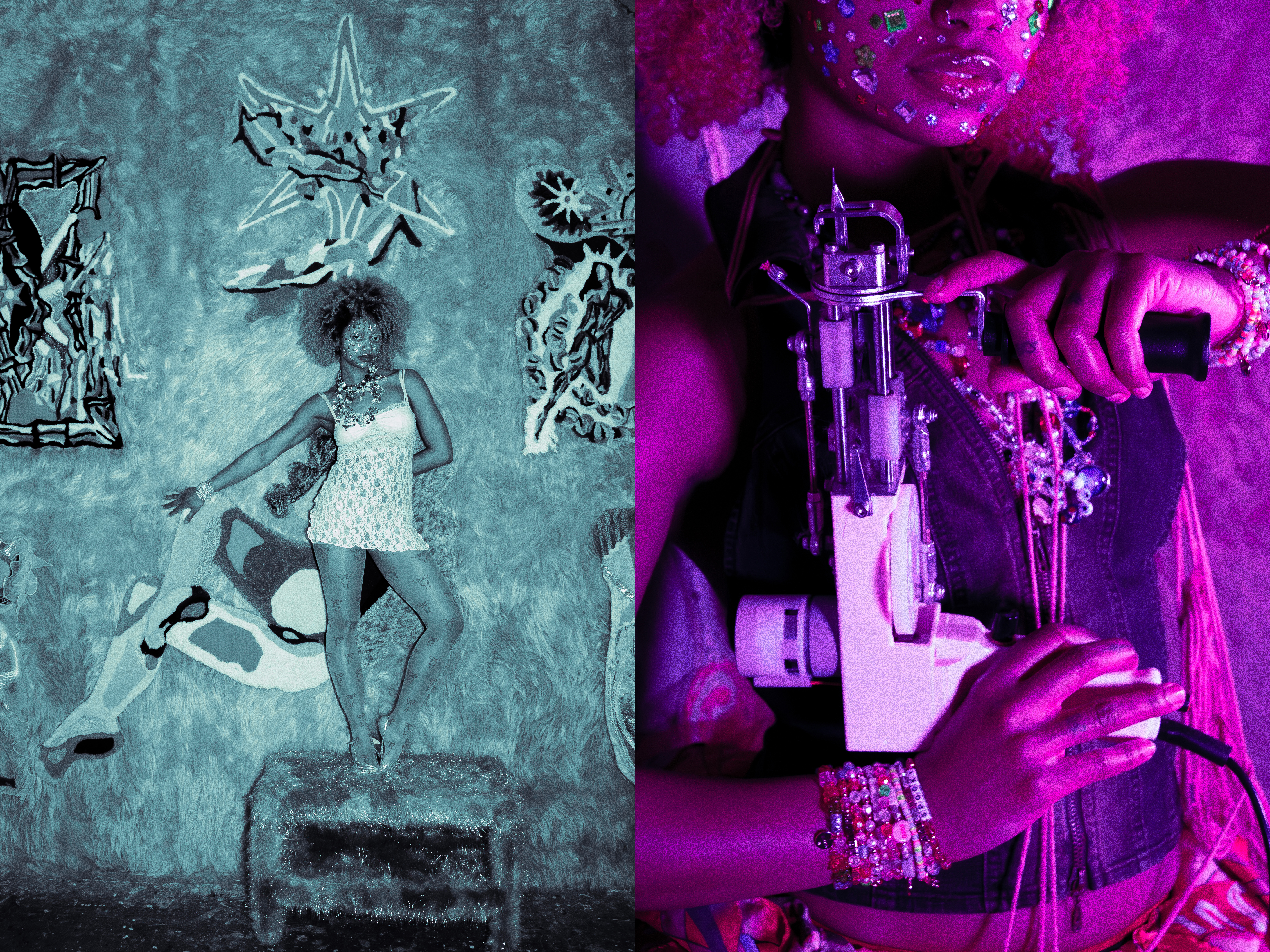
D: Do you feel the impact of you embodying and becoming this artist that the future kids can look up to and like can be like, I can make art however I want to make it, and look however I want to look?
T: It took me a long time to kind of get out that box and not feel angry at myself for not making works that's “fighting for something” and I think the reason I also felt like that too is because in school it'll, you almost felt like this is the kind of work that you have to make, like you're black and you're traumatic. I was like, oh, but I don't have to be a preset. I don't think my life is traumatic. And I've seen so many artists make conceptual work that had to do with the Black experience, but then I also realized they were dealing with a different time.
I realized this is my purpose. I thankfully was born in an era where I can be myself, I can dye my hair, I'm gonna love who I want, I can dress how I want. I'm not fighting. So it took a while for me to realize that and not feel bad about not having to fight. Yeah, and my grandparents. They're from the south. They're from Virginia, North Carolina. But they even moved to New York when they were like nine or ten years old. So I would go back to Virginia and see the confederate flag, but not necessarily have to deal with that; that really wasn't my experience. My experience is more like microaggressions or the way people treat me because of the way I look.
D: You're talking from your authentic voice, you have your own divine vision.
T: Yeah, it's like, why not make art this joyful? It's just as important to see yourself and other people's work, that's like cool, I can be happy. I don't have to feel the burden of the past.

D: I’d love to hear more about the influences of growing up in New York, specifically Brooklyn. You still live here and have your studio here. How has it impacted you?
T: Yeah, I'm born and raised in Brooklyn, New York. I grew up in Crown Heights. I went to school in Crown Heights. I grew up around the corner from the Brooklyn Museum. But I never went to a lot of museums growing up. That wasn't something that was done for fun. I think a lot of places in general, like for black people, it didn’t feel like, ‘oh, you can just come into the space and learn, it's okay.’
My mom is a very sports-centered person, so she put me and my brother in soccer and football tried to occupy our time so that we weren't out on the streets. I spent a lot of my time just like inside places being creative or I was in church and my grandparents, they lived downtown Brooklyn, everything is so different I mean even in Crown Heights, too like everything is crazy, crazy different and even just I guess seeing that change and seeing people come from like all different places is like exciting.
I'm not even gonna lie, it's sad to see that the... I guess, the people that I grew up with want to move to different places. Yeah, I'm tired of the hustle and bustle and living in New York: you're always running, like there's no slow pace, you always have to do something. I don't spend time at home just like watching a thing you know. There's not really any slow living in New York.
But like, I'm not a nature girl either. Yeah, I’m in the city. So, chickens and cows? No. (laughs) I love Brooklyn. Like we're here. I never knew this area, Red Hook. I only knew Ikea down here. So I'm even learning new things now that there are studios in West Bible. There's always something happening.


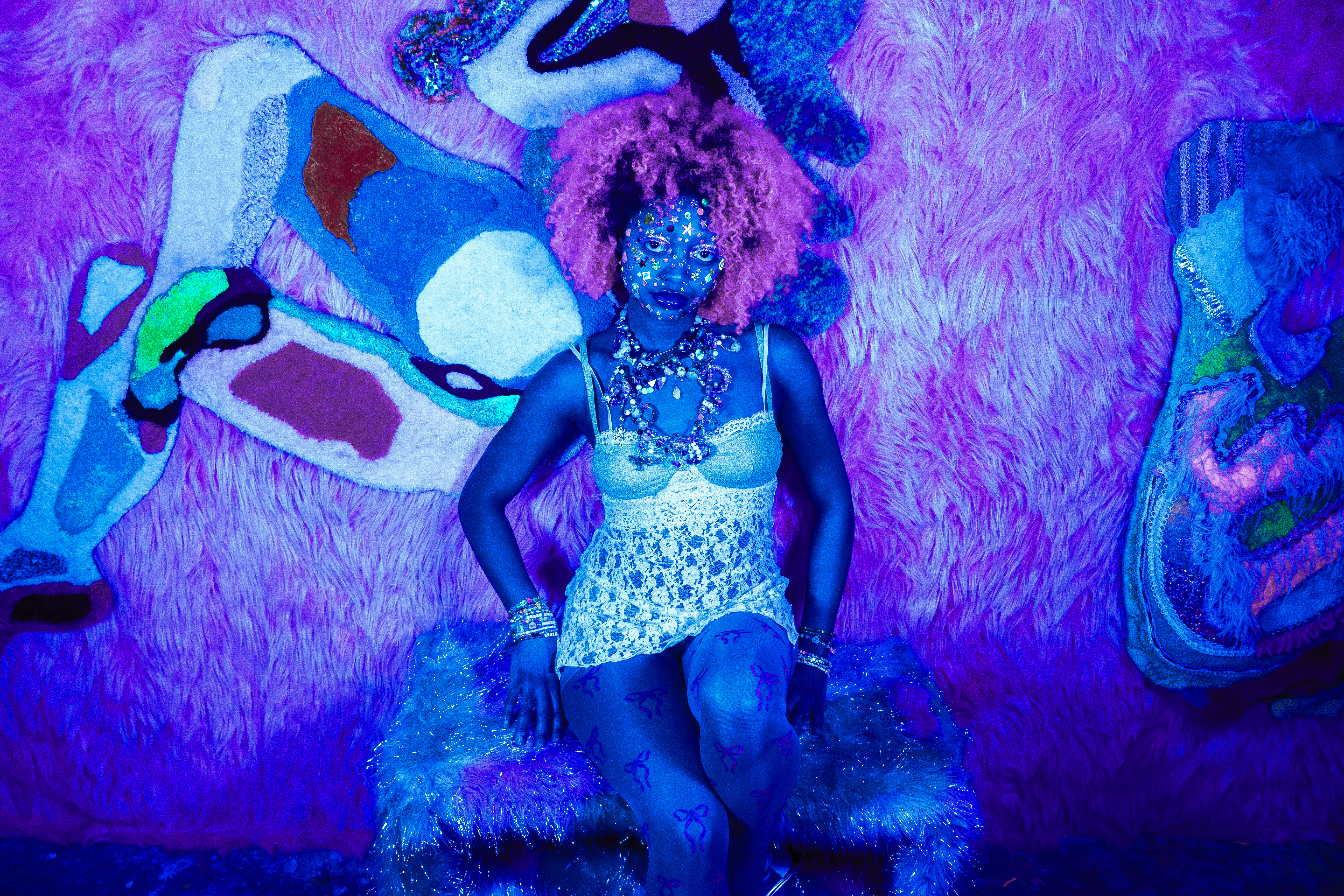
D: Okay, so back to your journey. You're coming out of school, you're starting to be more committed, and taking your work seriously, finding your voice.
While yes, you’re doing things for fun, there is a structured professional element to your work. I’d love to hear about your transition from art as pure creative expression to art as expression PLUS career. Any advice?
T: It was like 2019 when everything went down. I was showing abstract pieces at gallery events. I guess people still do this - there would be art, but it would also be a party, and it would be places for people to vend as well. And sometimes you couldn't even see the art because it was dark. But you know, it was fun for what it is, and that was when I first started to try and sell work. I also started doing things like street fairs. I would start vending my work and then I even live painted in the club one time- just like random shit.
After that, I had gotten my studio and I started doing like actual art fairs. And so that was kind of like a step up from the street fairs, I did like the future fair, the affordable art fair. And then, yeah, I don't know. I guess, did it become professional when I started showing on white walls?
I started determining where I would want to show my work. I learned the different audiences that places bring in and, whether or not people respect what you're showing or where you're showing. Now, I don't say yes to every opportunity, but I say yes if I feel the opportunity is going to do something for me. I mean, anyone can throw a fucking event. That's what I learned, too: not everyone can be a salesperson, but everyone can be a curator.


D: How do you balance your time? Are there any practices or methodologies you rely on?
T: So, if I'm not at work. I'm in the studio, and if I'm not working, I'm hanging out with my friends or going gallery hopping or going to a museum, so my life is surrounded by art. Not all of my friends are artists, but I usually do things related to art.
I do try to spend most of my time here making work, and I give myself deadlines for bigger pieces. I think this year and last year, I wanted to take more time to work on bigger pieces. I feel like the past five years, I was just cranking out so much work because I was showing so much because I was selling at fairs and things like that. And you also want to create a lot of work because I also like to apply to things too. So even when I'm at the studio, I might not be working, but I'm applying to things, and you don't want to apply with the same work. You always want to be better and evolve. I always say I want my work to evolve, and it has and it will.
And it just happens because I'm constantly creating, and the way that I'm getting into shows and things like that is people will find my stuff through social media. So if I'm not posting consistently or making work on a schedule, then it's like someone who missed my work. Like the show that I just dropped my work at today, she already had the show planned, and she saw my installation at 50th Street, forgot my name, and then just saw my work on Instagram. She was like” Sorry, you have to be in the show.” Honestly, that's how things just happen so fast. People will be like I'm doing a show in a month. I'm like girl… But you have to have pieces ready. Last year, a bunch of my pieces got brought by this one person, and I was like, okay, I have to make some more work.
I always say: “just make work.”


D: Even though your work is rooted in play, joy, and experimentation, we can tell that you're out here hustling. This is a job, you're on a mission. What are some challenges people may not expect about your practice?
T: There’s a lot of writing! You have to write various artist statements, proposals, etc. [I think] you have to have a website, you know, you really just learn along the way..
Also deciding on pricing. Pricing is so tricky. At the end of the day, I started to be like, I’d rather have people have my work rather than the work sit in my studio… and I can always make another piece. So my pricing varies, I work with the commission budget.
I realized that people didn't know how to buy my work. So I started making smaller pieces now, and I'm just selling them on my Instagram. For the bigger works, that's just reserved for galleries and if people want to inquire. If people like your stuff, they're going to inquire. But - I think that word is also very scary for people. Inquiries? Like girl, didn't inquire me. (laughs) But have a PDF of your work, have a deck. Teaching people how to approach you and inquire about your work is so important.
D: Let’s talk about some of the collaborations that you've done. How did those come about? How did they feel?
T: So, I just talked to people and told them my aspirations and goals of what I would like to do. A few years ago, I did a window display for Bergdorf and before that, I did a lecture talk at FIT saying how I was interested in doing things like window displays. And so my friend, who was my mentor back in college, had this connection and was like, “Oh, this young artist would be great for that.”
And even the Nike collaboration. My friend started working at Nike. I think she had found my work on Instagram, and they invited me to sell my work there. And I was just early stages, making ashtrays out of faux fur and then phone cases and stuff like that. Then I just like progressed from there.
It’s good to know the different paths that you can take as an artist. You don't necessarily have to be traditional, like get represented, go to a gallery route. You can do other things and carve your own path.

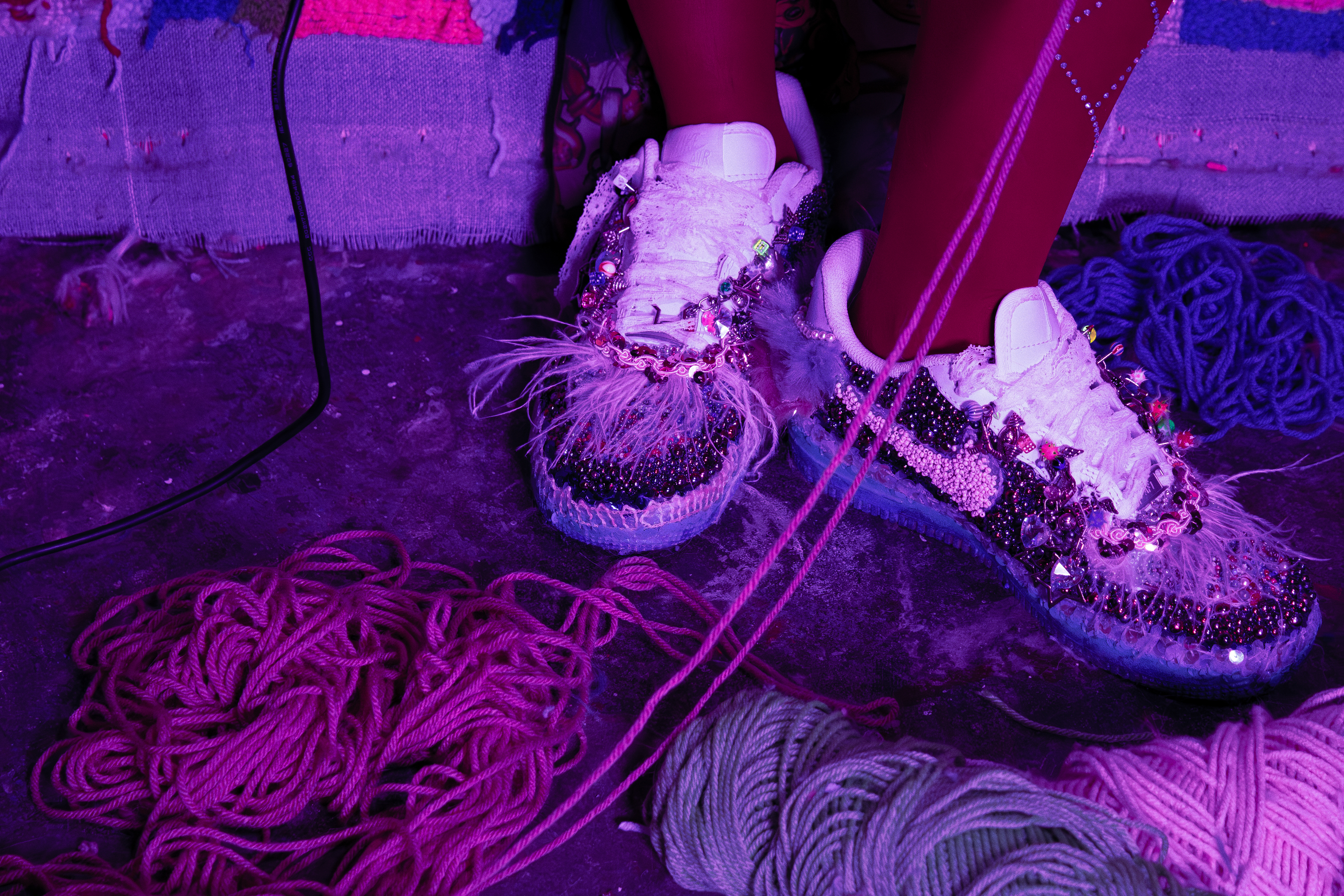
D: Can you talk about your relationship with spirituality today?
T: In church, around you, there are very prominent images. I guess you have heard this before, but good things come in threes. The Father, the Son, the Holy Spirit… sacred like geometry, etc.
I've been delving into this as well, but there are patterns and images that you see in nature, but also in the church that I've seen subconsciously, and so that has also been adapted into my work. I also represent a lot of the figures in threes, which represents my past, my present, my future.
The angel wings [are a motif]. I always feel like my family is watching over me, so they're even incorporated into some of the landscapes of my pieces.
I'm someone who also loves to dream and sleep, so that’s also another portal that's opening. I’m interested in what I'm feeling and looking at when I'm sleeping and not here; when I’m in the astrals.
But I think, yeah, I think it just comes like subconsciously what I have grown up seeing. And in my church too, there were literally just stained glass windows all over the church of Jesus and his disciples and the stories and things like that. So narrative was also like just very heavy growing up because of all the stories that I would hear. And I guess now I've delved a little bit more into that, and because I've seen people are more keen to like narrative and like figurative work rather than like abstract work.

D: What's your dream state for someone to approach your work or your spaces? Are there any rituals or gestures that are ideal in your mind to receive the work?
T: I think in church it's more like a respectful thing that I learned. You have to be very disciplined and humble yourself, I guess, when you're in a space like that, and I guess I value those attributes as well when people do walk into my safe spaces. But, I haven't had any negative people come in. When they see my work it's instantly like a smile, which really warms me up. And even when I see people in the subway, when I'm there and they don't even know I'm the artist. That's literally the one thing that they do is smile. I want people to be open-minded and for their shield to kind of like come off – this is a place where you don't have to have that on.
Also I hope they’re respectful of the work. When I do have my soft sculptures, sometimes people are very crazy with them. [I hope they] realize that it's as fragile as it is strong, which is also a representative of myself and people in general as well. Hard and soft. This is all a world of contradictions. So I hope they respect that as well, when you come into this space. Let your guard down.
